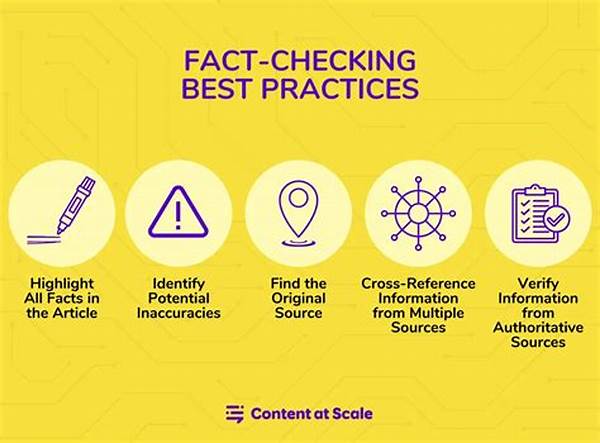In an era where information is disseminated at an unprecedented pace, the accuracy of original sources becomes crucial in shaping our understanding of truth. Scrutinizing original source accuracy requires a detailed examination of the fundamental truths presented in these sources and their alignment with factual realities. This practice is essential to maintain the credibility of information, especially in environments easily swayed by misinformation and biases. In this article, we delve into the significance of scrutinizing original source accuracy, exploring its impact on knowledge dissemination, and discuss methodologies to enhance the reliability of original sources.
Read Now : Building Empathy Through Social Values
The Importance of Accurate Source Verification
The proliferation of digital platforms has amplified the necessity for accurate source verification. Scrutinizing original source accuracy entails a rigorous process of validating facts from their inception to prevent the perpetuation of errors. This exercise is integral to safeguard public discourse from the influence of distortions and inaccuracies. As misinformation can easily permeate social and traditional media, emphasizing authenticity and precision in source material is paramount. Society’s dependence on technological channels for news and information underscores the criticality of scrutinizing original source accuracy to ensure the integrity and reliability of information consumed by the public.
Furthermore, scrutinizing original source accuracy safeguards the principles of journalistic integrity and academic research. Scholars and journalists alike bear the responsibility of tracing information to its origin, maintaining meticulous records to verify claims and arguments presented in their work. This level of scrutiny ensures that the knowledge propagated across various domains remains rooted in truth and reliability. Ultimately, the practice of scrutinizing original source accuracy upholds the values of credibility and trust, which are foundational to any informative or educational pursuit. As information consumers, recognizing the weight of this responsibility fosters a more discerning public, equipped to challenge and question information with confidence.
Methods to Enhance Accuracy in Source Verification
1. Cross-Referencing Information: Scrutinizing original source accuracy involves comparing data with different sources to identify consistencies or discrepancies. By validating information across multiple references, inaccuracies can be detected and corrected.
2. Utilizing Fact-Checking Tools: Employing digital tools designed for fact-checking supports the scrutinizing original source accuracy through instant validation of statements against established databases or verified reports.
3. Consulting Subject Matter Experts: Engaging with experts in relevant fields aids in scrutinizing original source accuracy by getting insights on validity, interpretation, and context of original source material.
4. Evaluating Source Credibility: Assessing the credibility of the source from which information originates is a means of scrutinizing original source accuracy, focusing on author reputation, publication history, and source intent.
5. Understanding Context and Bias: Scrutinizing original source accuracy requires evaluating the context in which information is presented, and identifying any inherent biases that could affect the source’s objectivity or reliability.
The Role of Technology in Scrutinizing Source Accuracy
The advent of sophisticated technology has dramatically influenced the methodologies used in scrutinizing original source accuracy. Artificial intelligence and machine learning algorithms can process vast amounts of data, identifying patterns and discrepancies faster than manual methods. These technologies facilitate the automation of fact-checking processes, ensuring that information validated aligns with established truths. The deployment of such tools in scrutinizing original source accuracy plays a pivotal role in maintaining the fidelity of information dissemination and mitigating the spread of misinformation.
Read Now : Importance Of Goal Setting In Education
Moreover, blockchain technology is being explored for its potential to preserve the integrity of original sources. By utilizing a decentralized ledger, provenance of information can be meticulously tracked and verified at each step in its dissemination journey. This transparency and immutability in verifying information pathways offer a promising frontier in scrutinizing original source accuracy. As technology continues to advance, its incorporation into the verification process not only enhances efficiency but also provides a robust framework for ensuring that the origins of information remain uncontested and truthful.
Steps to Implement Thorough Source Examination
The Impact of Missteps in Source Accuracy Analysis
The ramifications of failing to accurately scrutinize original source accuracy can be profound and far-reaching. Missteps in this process often lead to the propagation of misinformation, diminishing public trust and credibility in topics ranging from science to politics. As misinformed narratives are perpetuated, they contribute to societal polarization, hinder informed decision-making, and potentially lead to negative real-world consequences. Therefore, meticulously scrutinizing original source accuracy is not merely an academic exercise but a societal imperative that ensures informed citizenry and the maintenance of democratic processes.
Furthermore, inaccuracies that escape the scrutiny of original source validation have the potential to damage reputations, disrupt academic progress, and skew public opinion based on falsehoods. In an era where ‘fake news’ and information manipulation are prevalent, entities entrusted with information dissemination must exhibit diligence in scrutinizing original source accuracy at every stage. A failure to uphold these standards undermines societal discourse, and addressing this challenge demands concerted efforts and universal buy-in from all stakeholders involved in content creation and distribution.
The Ongoing Challenge of Source Accuracy in the Information Age
The constantly evolving digital landscape presents an ongoing challenge for scrutinizing original source accuracy. The sheer volume of information being created and shared poses a significant obstacle for those tasked with verifying its authenticity. Information is often presented as definitive without adequate scrutiny, which necessitates vigilance and advanced verification techniques to rebut inaccuracies effectively. Despite these challenges, fostering collaborations across technological, academic, and public domains can significantly enhance efforts in scrutinizing original source accuracy.
In conclusion, scrutinizing original source accuracy is an enduring responsibility that must adapt to the complexities of modern communication channels. By embracing technological advancements and fostering a culture of critical analysis, the challenges presented by vast information networks can be navigated effectively. Ensuring the accuracy and integrity of original sources is a collective endeavor that underpins the credibility and trustworthiness of all informational outputs. Continuing to prioritize and develop strategies for scrutinizing original source accuracy will safeguard the sanctity of information in contemporary society.
